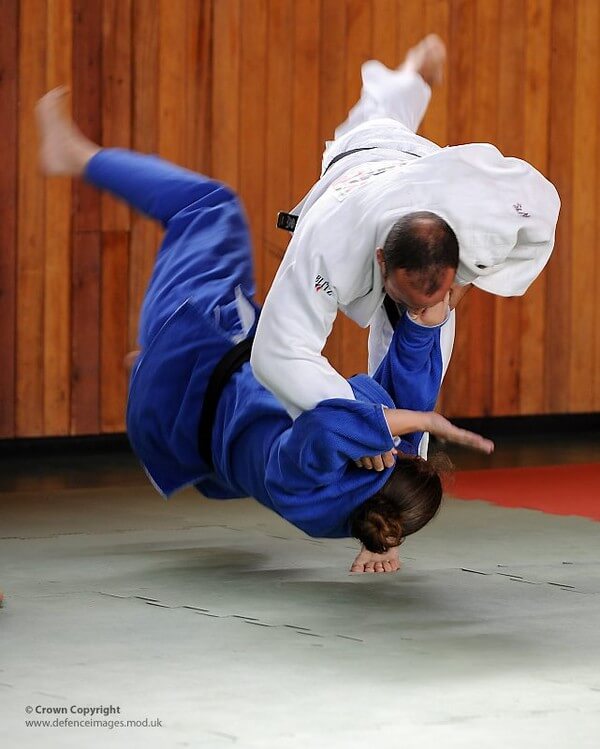Is Judo a Fix for Flat Feet plus a way to Flatten your Opponent?

Babies are born with flat feet but usually develop arches by their 6th birthday, according to the American Academy of Pediatrics.
For the study, researchers in Poland recruited 29 boys enrolled in 90-minute judo classes three times a week and 29 boys who didn’t participate in sports outside of school. Both groups were 11.5 years old, on average, and had similar body types.
The researchers assessed boys’ foot-arch height in both sitting and standing positions and measured balance with a so-called flamingo test: The boys stood on one leg for as long as possible on a strip of wood about 1 inch wide, holding the other leg bent at the knee.
Boys who practiced judo had significantly higher arches compared with nontrained boys. The best flamingo test score in the judo group was 125.1 seconds, compared with 27.3 seconds in the control group. The worst scores in the judo-trained and nontrained groups were 4.7 and 1.2 seconds, respectively.
Caveat: The study was small and didn’t include girls
Summer swoon: Older people taking blood-pressure medication may need lower dosages during the hot summer months to help prevent fainting, suggests a study published online in the American Journal of Medicine. The study found fainting episodes, called syncope, were significantly more common in summer than in winter among patients taking antihypertensive drugs. Nearly 75% of patients with summer syncope were age 60 or older.
Older people normally have a greater risk of syncope than younger people. Antihypertensive medications and dehydration from high summer temperatures further increase the risk, the researchers said.
Researchers at the University of Arizona in Tucson reviewed medical records of 834 patients hospitalized for syncope from 2010 to 2013. About 57% were treated between May and September, the warmest months in Tucson, and the rest from November to March. Among those on blood-pressure medications, representing just over a third of the total patients, 40.5% developed syncope during the summer months, compared with 29% in the winter.
Summer syncope was associated with dehydration and was more common in women. By contrast, more men developed syncope in winter.
Angiotensin converting enzyme, or ACE, inhibitors and angiotensin receptor blockers were the most commonly prescribed medications, followed by beta-blockers and calcium-channel blockers. The number of medications patients were taking was unrelated to syncope, the research showed.
Caveat: The study was relatively small and conducted at one hospital.
Functional fat: Cosmetic surgery to reduce excess fat in the thighs could increase the risk of cardiovascular disease, suggests a small study in the American Journal of Physiology−Endocrinology and Metabolism. The study found that triglycerides, a type of fat in the blood associated with heart health, increased significantly in women who had leg fat removed by liposuction, compared with a control group.
Previous studies have shown that carrying excess fat in the hips and thighs, as opposed to in the abdomen, is associated with a lower risk of Type 2 diabetes, heart attacks and other cardiovascular conditions. This study found that removing leg fat increased triglycerides in the blood, the researchers said. This could contribute to disease risk.
More than 300,000 women and 40,000 men in the U.S. underwent various liposuction procedures in 2014, according to the American Society for Aesthetic Plastic Surgery.
The study, at the University of Colorado in Aurora, involved 29 normal-weight women, age 45 years old on average, seeking femoral or upper-leg liposuction. Seventeen of the women had the surgery, while 12 served as controls and were offered liposuction after the study. None of the subjects had high triglycerides or conditions associated with cardiovascular disease.
Fat samples from the subjects’ thighs and abdomen were measured at the start of the study, and two and 14 months after surgery. Body-composition changes were measured with CT scans and X-rays. There was no change in triglycerides two months postsurgery. But after 14 months, triglycerides increased by 24% in the liposuction group, though levels were still in the normal range. Triglycerides didn’t change in the controls.
Leg fat remained reduced 14 months after liposuction, and there were no increases in fat elsewhere in the body to compensate for leg-fat removal, the study said.
Caveat: It isn’t known if liposuction would trigger a similar response in obese women or those with a tendency to store fat in the abdomen, researchers said. The study didn’t include men.
